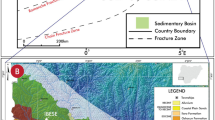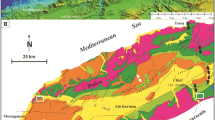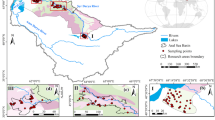Abstract
Major element compositions and chemical weathering features of the purple soils and their corresponding rocks in the Red Sichuan Basin, China were studied in this paper to infer the diagenetic features of the purple rocks and the pedogenetic features of the purple soils. The results showed that all of the rock and soil samples, except those from Yibin, have strongly similar major element compositions and the distribution patterns of their major element compositions are similar to those of the upper continental crust. Chemical index of alteration, chemical index of weathering and Na2O/K2O indicate that the purple soils and rocks have similar chemical weathering intensities, whereas the Al2O3–CaO* + Na2O–K2O (A–CN–K) relationship, suggests that chemical weathering was strong during diagenesis of the purple rocks, but weak during pedogenesis of the purple soils. Variations in major element compositions of the purplish rock samples, except that from Yibin, do not primarily reflect differences in compositions of the sediment source, sediment recycling and potassium metasomatism, and therefore the effects of chemical weathering on the major element compositions were mainly dependent on climate condition and the residence time of material exposed to chemical weathering. Chemical weathering of the purple rocks reached only moderate degrees under the general influence of warm and humid climate during Jurassic and Cretaceous. Warmer and more humid climate conditions partly resulted in stronger chemical weathering of rocks in the southern region of the basin than in the central and western region, whereas shorter residence time of material in upslope position partly resulted in weaker chemical weathering of rocks in the eastern region than in the central and western region. The same climate and stable tectonic setting led to comparable chemical weathering intensities of rocks in the Ziliujing and Jiaguan Formations. Gradually colder and dryer climate from Early Jurassic to Middle Jurassic then to Late Jurassic and shorter residence time in tectonically active setting of Middle Jurassic and late Late Jurassic resulted in the following order of chemical weathering intensity of the purple Jurassic rocks: Ziliujing Formation ≫ Shaximiao Formation ≈ Suining Formation > Penglaizhen Formation.




Similar content being viewed by others
References
Amundson R, Jenny H (1997) On a state factor model of ecosystems. Bioscience 47:536–543
Araki S, Kyuma K (1985) Characterization of red and/or yellow colored soil materials in the southwestern part of Japan in terms of lithology and degree of weathering. Soil Sci Plant Nutr 31:403–410
Basu A (1976) Petrology of Holocene fluvial sand derived from plutonic source rocks: implications to paleoclimatic interpretation. J Sediment Petrol 46:694–709
Bureau of Geology and Mineral Resources of Sichuan province (1991) Geology of Sichuan province (in Chinese), Geological Memoirs Series 1, No. 23, Geol. Publ. House, Beijing, pp 242–282
Chen J, Ji J, Qiu G, Zhu H, Lu H (1997) Geochemistry of the chemical weathering intensity of the loess profile in Luochuan. Shaanxi Province. Science in China 27(6):531–536 (In Chinese with English abstract)
Chen J, An Z, Liu L, Ji J, Yang J, Chen C (2001) Variations in chemical compositions of the eolian dust in Chinese Loess Plateau over the past 2.5 Ma and chemical weathering in the Asian inland. Sci China (Series D) 31(2):136–145 (in Chinese with English abstract)
Corcoran PL, Mueller WU (2002) The effects of weathering, sorting and source composition in Archean high-relief basins: examples from the Slave Province, Northwest Territories, Canada. In: Altermann W, Corcoran PL (Eds.) A modern approach to ancient depositional systems. Special Publications of the International Association of Sedimentologists, pp 183–211
Corcoran PL, Mueller WU, Padgham W (1999) Influence of tectonism and climate on lithofacies distribution and sandstone and conglomerate composition in the Archean Beaulieu rapids formation, Northwest Territories Canada. Precambrian Res 94:175–204
Cox R, Low DR (1995) The influence of sediment recycling and basement composition on evolution of mudrock chemistry in the southwestern United States. Geochimica el Cosmochimica Acta 59:2919–2940
Cullers RL (2002) The source and origin of terrigenous sedimentary rocks in the Mesoproterozoic Ui group, southeastern Russia. Precambr Res 117:157–183
Cullers RL, Podkovyrov VM (2000) Geochemistry of the Mesoproterozoic Lakhanda shales in southeastern Yakutia, Russia: implications for mineralogical and provenance control, and recycling. Precambr Res 104:77–93
Fedo CM, Nesbitt HW, Young GM (1995) Unraveling the effects of potassium metasomatism in sedimentary rocks and paleosols, with implications for paleoweathering conditions and provenance. Geology 23(10):921–924
Fedo CM, Eriksson KA, Krogstad EJ (1996) Geochemistry of shales from the Archean (~3.0 Ga) Buhwa greenstone belt, Zimbabwe: implications for provenance and source-area weathering. Geochim Cosmochim Acta 60:1751–1763
Fedo CM, Young GM, Nesbitt HW et al (1997) Potassic and sodic metasomatism in the Southern Province of the Canadian Shield: evidence from the Paleoproterozoic Serpent Formation, Huronian Supergroup Canada. Precambrian Res 84:17–36
Fralick PW, Kronberg BI (1997) Geochemical discrimination of clastic sedimentary rock sources. Sediment Geol 113:111–124
Grantham JH, Velbel MA (1988) The influence of climate and topography on rock-fragment abundance in modern fluvial sands of the southern Blue Ridge Mountains North Carolina. J Sediment Petrol 58:219–227
Gromet LP, Dymek RF, Haskin LA et al (1984) The North American shale composite: its compilation, major and trace element characteristics. Geochim Cosmochim Acta 48:2469–2482
Guo ZW (1996) Formation and evolution of Sichuan Basin. Geological Publishing House, Beijing (in Chinese), pp 113–120
Harnois L (1988) The CIW Index: a new chemical index for weathering. Sediment Geol 55:319–322
He YR (2003) Purple soils in China, vol 14. Chinese Science Press, Beijing, pp 80–81 (in Chinese)
He YR, Chenvol XH, Gong ED (1999) Mineral composition and classification of three kinds of entisols in Sichuan Basin. Chin J Soil Sci 12(30):57–59 (in Chinese)
Holail HM, Moghazi AKM (1998) Provenance, tectonic setting and geochemistry of greywackes and siltstones of the late Precambrian Hammamat Group. Egypt Sediment Geol 116:227–250
Johnsson MJ (1993) The system controlling the composition of clastic sediments. In: Johnsson MJ, Basu A (eds) Processes controlling the composition of clastic sediment, vol. 284. Special Paper of the Geological Society of America, London, pp 1–19
Johnsson MJ, Stallard RF (1989) Physiographic controls on the composition of sediment derived from volcanic and sedimentary terrains on Barro Colorado Island, Panama. J Sediment Petrol 59:768–781
Kautz CQ, Martin CE (2007) Chemical and physical weathering in New Zealand’s Southern Alps monitored by bedload sediment major element composition. Appl Geochem 22:1715–1735
Li QG, Liu SW, Han BF et al (2005) The geochemical characteristic of meta-mudstone and its effect on provenance and paleo-weathering in the Xing–xing Gap of the east part of Middle Tian san Mountain. Science in China (Series D) 35(3):225–234
Mack GH (1981) Composition of modern stream sand in a humid climate derived from a low-grade metamorphic and sedimentary foreland fold-thrust belt of north Georgia. J Sediment Petrol 51:1247–1258
MacLean WH (1990) Mass change calculations in altered rock series. Miner Deposita 25:44–49
McLennan SM (1993) Weathering and global denudation. J Geol 101:295–303
McLennan SM, Hemming S, McDaniel DK et al (1993) Geochemical approaches to sedimentation, provenance and tectonics. Geol Soc Am Spec Pap 284:21–40
Nesbitt HW, Markovics G (1997) Weathering of granodioritic crust, long-term storage of elements in weathering profiles, and petrogenesis of siliciclastic sediments. Geochim Cosmochim Acta 61(8):1653–1670
Nesbitt HW, Young GM (1982) Early Proterozoic climates and plate motions inferred from major element chemistry of lutites. Nature 299(21):715–717
Nesbitt HW, Young GM (1984) Prediction of some weathering trends of plutonic and volcanic rocks based on thermodynamic and kinetic considerations. Geochim Cosmochim Acta 48:1523–1548
Nesbitt HW, Young GM (1989) Formation and diagenesis of weathering profiles. J Geol 97:129–147
Nesbitt HW, Young GM (1996) Petrogenisis of sediments in the absence of chemical weathering: effects of abrasion and sorting on bulk composition and mineralogy. Sedimentology 43:341–358
Nesbitt HW, Fedo CM, Young GM (1997) Quartz and feldspar stability, steady and non-steady state weathering, and petrogenesis of siliciclastic sands and muds. J Geol 105:173–191
Ou SP, Xu Z, Zhang SS et al (2002) Applying Geochemistry to Research into Meso—Cenozoic climate: discussion on Jurassic Climatic Change in Sichuan Basin, China. J Qingdao Inst Chem Technol 23(1):5–9 (In Chinese with English abstract)
Panahi A, Young GM, Rainbird RH (2000) Behavior of major and trace elements (including REE) during Paleoproterozoic pedogenesis and diagenetic alteration of an Arcbean granite near Ville Marie, Quebec, Canada. Geochim Cosmochim Acta 64:2199–2220
Pettijohn FJ, Potter PE, Siever R (1972) Sand and sandstone. Springer, New York, p 618
Roser BP, Korsch RJ (1988) Provenance signatures of sandstonemudstone suites determined using discriminant function analysis of major-element data. Chem Geol 67:119–139
Sichuan Province Agriculture Bureau (1995) Soil in Sichuan. Sichuan Science and Technology Press, Chengdu, pp 67–68
Sugitani K, Horiuchi Y, Adachi M et al (1996) Anomalously low Al2O3/TiO2 values for Archean cherts from the Pilbara block, weastern Australia—possible evidence for extensive chemical weathering on the early earth. Precambrian Res 80:49–76
Taylor SR, McLennan SM (1985) The Continental crust: its composition an d Evolution. Blackwell, London, p 277
Wang HM, Liu YY, Wang ZY (2001) Molecular fossils as indicatorsfor paleoencironment and paleoclimate from red clastic rocks of middle Jurassic-early Cretaceous in jianmenguan, Sichuan basin of China. Earth Sci J China Univ Geosci 26(3):229–234 (In Chinese with English abstract)
Wei CF (1989) On particle size distribution of purple soil and its chemical composition in southern Sichuan basin. J Southwest Agric Univ 11(5):434–437 (In Chinese with English abstract)
Wei CF, Ni JP, Gao M et al (2006) Anthropic pedogenesis of purple rock fragments in Sichuan basin, China. CATENA 68(1):51–58
Wintsch RP, Kvale CM (1994) Differential mobility of elements in burial diagenesis of siliciclastic rocks. J Sediment Res A64:349–361
Zhang XB, Qi Y, Walling DE, He X, Wen A, Fu J (2006) A preliminary assessment of the potential for using 210 Pbex measurement to estimate soil redistribution rates on cultivated slopes in the Sichuan Hilly basin of China. CATENA 68(1):1–9
Zhu B, Wang T, You X, Gao MR (2008) Nutrient release from weathering of purplish rocks in the Sichuan basin, China. Pedosphere 18(2):257–264
Acknowledgments
This research was supported by National Key Technology R&D Program of China (2012BAD05B06) and Chongqing Science and Technology Commission Foundation (CSTC,2009BB1115), and supports are gratefully acknowledged. Special thanks go to Chenyang Xu for her assistance in English writing.
Author information
Authors and Affiliations
Corresponding author
Rights and permissions
About this article
Cite this article
Du, J., Luo, Y., Zhang, W. et al. Major element geochemistry of purple soils/rocks in the red Sichuan Basin, China: implications of their diagenesis and pedogenesis. Environ Earth Sci 69, 1831–1844 (2013). https://doi.org/10.1007/s12665-012-2019-y
Received:
Accepted:
Published:
Issue Date:
DOI: https://doi.org/10.1007/s12665-012-2019-y




